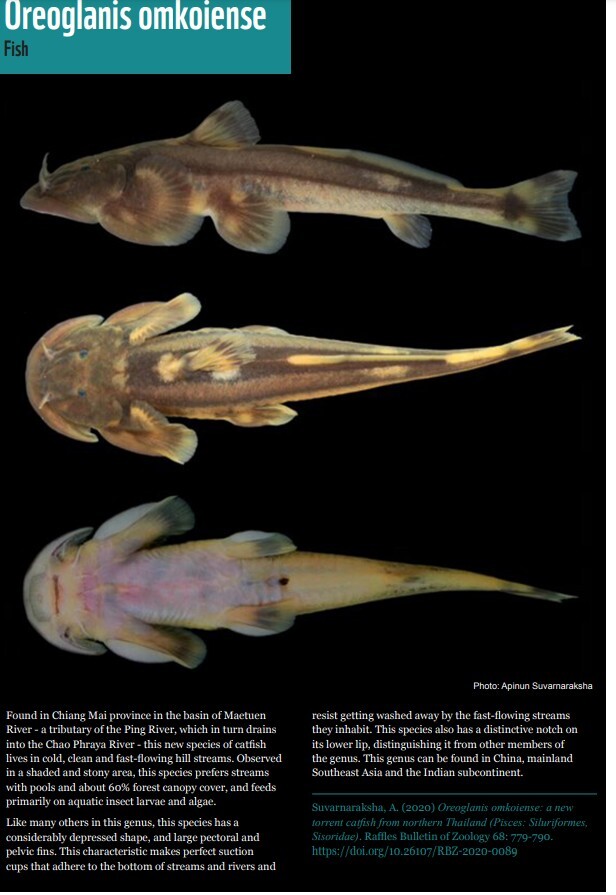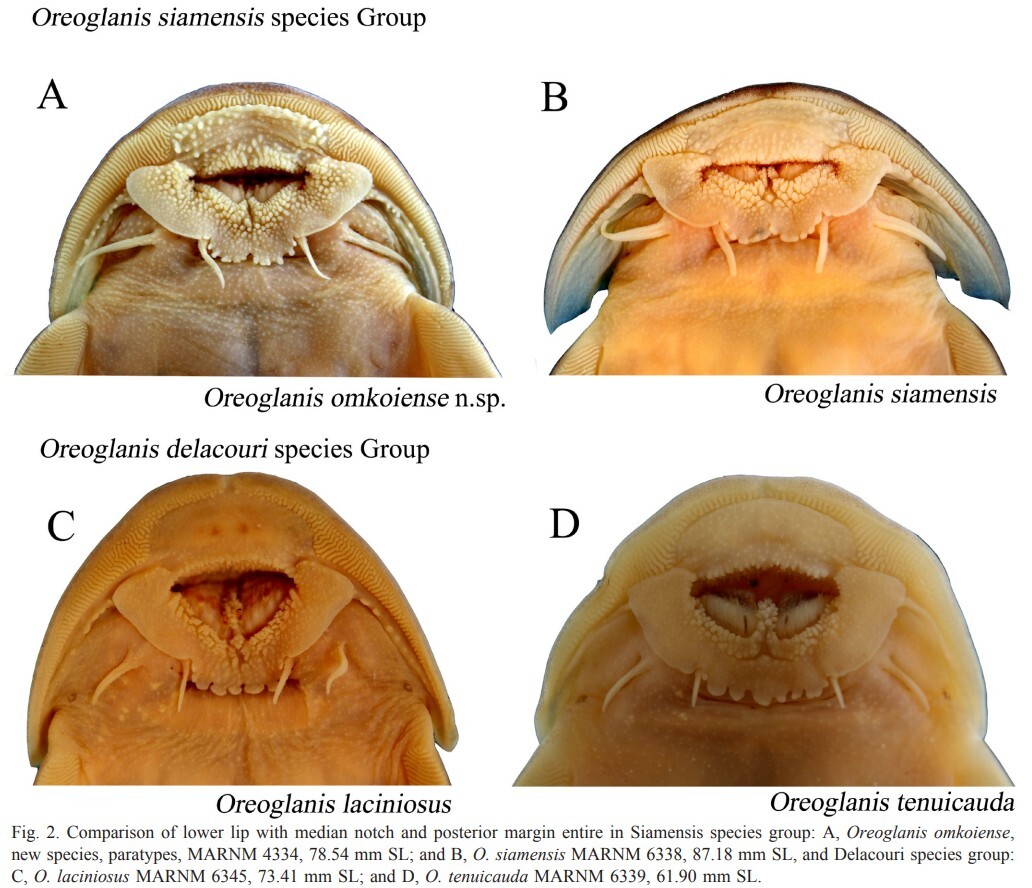New Oreoglanis
- Silurus
- Posts: 12373
- Joined: 31 Dec 2002, 11:35
- I've donated: $12.00!
- My articles: 55
- My images: 884
- My catfish: 1
- My cats species list: 90 (i:0, k:0)
- Spotted: 419
- Location 1: Singapore
- Location 2: Moderator Emeritus
- bekateen
- Posts: 8983
- Joined: 09 Sep 2014, 17:50
- I've donated: $40.00!
- My articles: 4
- My images: 130
- My cats species list: 142 (i:102, k:39)
- My aquaria list: 36 (i:13)
- My BLogs: 44 (i:149, p:2671)
- My Wishlist: 35
- Spotted: 177
- Location 1: USA, California, Stockton
- Location 2: USA, California, Stockton
- Contact:
Re: New Oreoglanis
Abstract
, new species, is described from the Maetuen River basin, a tributary of Ping River in northern Thailand, it is found in the highland stream. This species is a member of the O. siamensis species group, characterised by a lower lip with median notch and posterior margin entire. Oreoglanis omkoiense has a long adipose fin base length, short post-adipose fin, long nasal barbels reaching anterior margin of eye, tip of maxillary barbel pointed, pectoral fin tip not reaching pelvic-fin origin, short pelvic fin, long pre-dorsal length, and thick and short caudal peduncle.
- Key words. Omkoi, Metuen River, conservation, fish diversity, Southeast Asia
Cheers, Eric
Key to the species of Oreoglanis:
Adapted and modified from Ng & Kottelat, 1999; Ng & Freyhof, 2001; Ng & Rainboth, 2001; Ng, 2004; Chen et al., 2017; Kong et al., 2007; Vidthayanon et al., 2009; Linthoingambi & Vishwanath, 2011; Sinha & Tamang, 2015; Chen et al., 2017. Note: CP = Chao Phraya River basin, MK = Mekong River basin, SW = Salween River basin, ID = Irrawaddy River basin, BP = Brahmaputra River basin, SL = Song Lam River basin.
- Lower lip notched medially, with entire or weakly laciniate posterior margin; emarginate caudal-fin .....2
- Lower lip lacking a median notch, with prominent projections along posterior margin; laciniate caudal-fin with principal caudal rays extended .....16
- Pectoral-fin not reaching to pelvic-fin origin .....3
- Pectoral-fin reaching or surpassing pelvic-fin origin .....5
- Head width 90.2–96.8%HL, post-adipose distance 5.7–8.8%SL and dorsal-fin high 15.4–20.3%SL ..... (CP)
- Head width 79.3–87.4%HL, post-adipose distance 8.4–14.3%SL and dorsal-fin high 11.4–14.4%SL .....4
- Caudal peduncle length and caudal peduncle depth ratio 4.9–8.4, adipose-fin base 29.1–36.7%SL and head 15.3–17.7%SL ..... (CP)
- Caudal peduncle length and caudal peduncle depth ratio 2.1–3.3, adipose-fin base 35.6–39.5%SL and head 18.7–22.9% ....., new species (CP)
- Branched anal-fin rays 2 ..... (SW)
- Branched anal-fin rays 3–6 .....6
- Caudal-fin lunate .....7
- Caudal-fin emarginate .....8
- Adipose-fin base length 24.2–29.7%SL, dorsal-fin base length 6.6–9.2%SL, anal-fin base length 2.5–3.6%SL ..... (MK)
- Adipose-fin base length 30.7–38.1%SL, dorsal-fin base length 10.9–13.7%SL, anal-fin base length 5.6–7.6%SL ..... (MK)
- Caudal-fin rays 5+5 ..... (ID)
- Caudal-fin rays 6+6 or 7+8 or 8+7 .....9
- Posterior margin of maxillary barbel with laciniate projections ..... (MK)
- Posterior margin of maxillary barbel without or with lobulated projections .....10
- Caudal peduncle depth 8.0–8.7%SL ..... (ID)
- Caudal peduncle depth 3.0–6.3%SL .....11
- Small eye 7.7–8.8%HL ..... (ID)
- Larger eye 9.0–13.7%HL .....12
- Branched anal-fin rays 3 .....13
- Branched anal-fin rays 4–6 .....14
- Post adipose-fin length 6.5–9.0%SL ..... (SW)
- Post adipose-fin length 9.9–10.8%SL ..... (BP)
- Dorsal to adipose-fin distance 21.1%SL ..... (BP)
- Dorsal to adipose-fin distance 14.4–16.0%SL ..... (SW)
- Maxillary barbel tip pointed ..... (CP)
- Maxillary barbel tip rounded .....16
- Branched dorsal-fin rays 7 ..... (MK)
- Branched dorsal-fin rays 5–6 .....17
- Post adipose distance short 2.8–7.0%SL .....18
- Post adipose distance short more than 7.0%SL .....19
- Emarginate caudal-fin shape ..... (CP)
- Lunate caudal-fin shape ..... (CP)
- Branched caudal-fin rays 7+7 .....20
- Branched caudal-fin rays 5–6+6–7, 7–6 .....22
- Long pre-dorsal length 36.1–37.1%SL ..... (MK)
- Pre-dorsal length short 30.8–36.5%SL .....21
- Anal-fin base length 2.7–3.6%SL, caudal peduncle length 18.7–21.7%SL, head width 18.9–22.4 %SL ..... (MK)
- Anal-fin base length 3.6–4.9%SL, caudal peduncle length 21.5–24.0 %SL, head width 16.4–20.8%SL ..... (MK)
- Post-adipose distance 9.0–13.8%SL, head depth 9.3–13.5%SL and pre-pelvic length 38.9–44.0%SL ..... (CP)
- Post-adipose distance 6.8–8.9%SL, head depth 7.3–8.0%SL and pre-pelvic length 33.1–9.4%SL .....23
- Branched dorsal-fin rays 6, small eye 7.5–9.8%HL, adipose-fin base length 36.7–47.8%SL, pectoral-fin length 23.0–24.4%SL and head length 18.8–20.7%SL ..... (MK)
- Branched dorsal-fin rays 5, small eye 10.5–12.1%HL, adipose-fin base length 31.7–36.0%SL, pectoral-fin length 25.3–26.4%SL and head length 21.4–24.7%SL ..... (SL)
Find me on YouTube and Facebook: http://youtube.com/user/Bekateen1; https://www.facebook.com/Bekateen
Buying caves from https://plecocaves.com? Plecocaves sponsor Bekateen's Fishroom. Use coupon code "bekateen" (no quotes) for 15% off your order.
-
Horlack
- Posts: 87
- Joined: 01 Mar 2015, 22:51
- My cats species list: 1 (i:1, k:0)
- My aquaria list: 1 (i:0)
- Location 1: France
- Location 2: France
- Contact:
Re: New Oreoglanis
224 New Species Discoveries in the Greater Mekong Region
Oreoglanis omkoiense (Great Mekong)
Source :
WWF Article : https://greatermekong.panda.org/our_sol ... sID=371976
WWF Article PDF (Better) : https://wwfasia.awsassets.panda.org/dow ... _final.pdf
DOI : https://doi.org/10.26107/RBZ-2020-0089


Oreoglanis omkoiense (Great Mekong)
Suvarnaraksha, A. (2020) Oreoglanis omkoiense: a new torrent catfish from northern Thailand (Pisces: Siluriformes, Sisoridae). Raffles Bulletin of Zoology 68: 779-790. https://doi.org/10.26107/RBZ-2020-0089Found in Chiang Mai province in the basin of Maetuen River - a tributary of the Ping River, which in turn drains into the Chao Phraya River - this new species of catfish lives in cold, clean and fast-flowing hill streams. Observed in a shaded and stony area, this species prefers streams with pools and about 60% forest canopy cover, and feeds primarily on aquatic insect larvae and algae. Like many others in this genus, this species has a considerably depressed shape, and large pectoral and pelvic fins. This characteristic makes perfect suction cups that adhere to the bottom of streams and rivers and resist getting washed away by the fast-flowing streams they inhabit. This species also has a distinctive notch on its lower lip, distinguishing it from other members of the genus. This genus can be found in China, mainland Southeast Asia and the Indian subcontinent.
Source :
WWF Article : https://greatermekong.panda.org/our_sol ... sID=371976
WWF Article PDF (Better) : https://wwfasia.awsassets.panda.org/dow ... _final.pdf
DOI : https://doi.org/10.26107/RBZ-2020-0089































